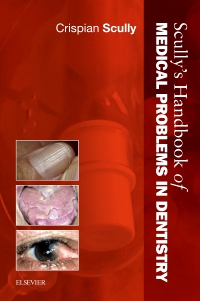
Scully's Handbook of Medical Problems in Dentistry - Elsevier eBook on VitalSource, 1st Edition
Elsevier eBook on VitalSource

-
- Highlights the main points of human diseases and their relevance to oral healthcare in a practical way
- Gives particular focus on areas that are of major concern to dentistry and oral healthcare e.g. allergies, bleeding tendencies, endocrine disorders - especially diabetes - gravid patients, hepatitis and other transmissible diseases, and malignant disease
- Explains the process of risk assessment, pain and anxiety control, patient access and positioning, treatment modification and drug use
- ‘Relevance for Dentistry’ boxes highlight the most crucial aspects of specific conditions
- Contains new national and international guidelines, further reading and up-to-date websites
- More than meets the needs of the UK General Dental Council (GDC) document ‘Preparing for practice; Dental team learning outcomes for registration’.
- Ideal for all dental students, general dental practitioners and hospital-based dentists together with other oral healthcare staff who need to keep up to date with medical knowledge
-
1 Health
Health promotion
Health hazards
2 Healthcare
Medical history
Preoperative assessment
Preoperative planning
Analgesia and behaviour management
Consent
Culture
3 Main emergencies
Emergency procedure
Management of common emergencies
4 Age and gender
Children
Men’s health
Bladder cancer
Prostate cancer
Prostate hypertrophy
Testicular cancer
Older patients
Women’s health
Breast cancer
Cervical cancer
Ovarian cancer
Uterine cancer
Pregnancy
Menopause
5 System synopses
Cardiovascular
Aortic valve disease
Cardiac arrhythmias
Cardiac failure
Cardiomyopathies
Cerebrovascular accidents
Congenital heart disease
Endocarditis
Hypertension
Ischaemic heart disease
Mitral valve disease
Myocardial infarction
Rheumatic fever
Surgery
Thrombosis
Endocrine and metabolic
Acromegaly
Addison disease
Cushing’s syndrome
Diabetes insipidus
Diabetes mellitus
HyperaldosteronismHyperparathyroidism
Hyperthyroidism
Hypoparathyroidism
Hypopituitarism (Dwarfism)
Hypothyroidism
Obesity
Gastrointestinal
Coeliac disease
Colorectal cancer
Crohn’s disease
Cystic fibrosis
Diverticular disease
Gastric cancer
Gastric ulcer (see Peptic ulcer)
Gastro-oesophageal reflux disease
Head and neck cancer
Irritable bowel disease
Oesophageal carcinoma
Peptic ulcer
Pancreatitis
Pancreatic cancer
Ulcerative colitis
Genito-urinary
Chronic kidney disease
Kidney cancer
Kidney stones
Nephrotic syndrome
Pyelonephritis
Haematological
Anaemia
Haemophilias
Leukaemias
Lymphomas
Myeloma (Myelomatosis, Kahler disease)
Neutrophil defects
Thrombocytopenia
Hepatic
Hepatitis
Liver diseases
Immunological
Allergies
Immunodeficiencies (Primary)
Lupus erythematosus
Scleroderma
Sjögren syndrome
Mental
Alzheimer disease (Alzheimer dementia)
Attention deficit hyperactivity disorder
Autism
Body dysmorphic disorder
Depression
Eating disorders
Mania
Obsessive-compulsive disorder
Panic disorder
Phobias
Schizophrenia
Self-harm
Mucocutaneous
Erythema multiforme
Lichen planus
Pemphigoid
Pemphigus
Skin cancers
Musculoskeletal
Ankylosing spondylitis
Gout
Osteoarthritis (Osteoarthrosis)
Osteogenesis imperfecta
Osteoporosis
Paget disease of bone
Rheumatoid arthritis
Rickets and osteomalacia
Neurological
Brain tumours
Epilepsy
Migraine
Multiple sclerosis (Disseminated sclerosis)
Myasthenia gravis
Parkinsonism
Trigeminal Autonomic Cephalgias
Trigeminal neuralgia
Respiratory
Asthma
Chronic obstructive pulmonary disease
Lung cancer
Pneumonia
Sarcoidosis
6 Trauma
Facial trauma
Head injury
Non-accidental injury
Spinal trauma
7 Infections
A range of infections
Candidosis (candidiasis)
Creutzfeldt-Jakob disease
Endocarditis (see Cardiovascular disease)
Gonorrhoea
Gonorrhoea
Herpes viruses
Healthcare Associated Infections
HIV/AIDS
Human papilloma viruses (HPV)
Syphilis
Tuberculosis
8 Chemical dependence (drug addiction: substance abuse)
Chemical dependence
Alcohol use
Amphetamine use
Cocaine and crack use
Ecstasy (methylene-dioxy methamphetamine) use
Lysergic acid diethylamide (LSD) use
Inhalant use
Legal highs
Marijuana use
Nicotine use
Opioid and heroin use
9 Therapeutic modalities
Adverse reactions to drugs
Anti-thrombotic agents
Biological therapies
Chemotherapy
Complementary and alternative medicine
Graft versus host disease
Haemodialysis
Immunosuppressive treatment
Implanted devices
Palliative and end of life care
Radiotherapy
Splenectomy
Steroids (corticosteroids)
Transplantation
10 Disability, vulnerability and impairment
Bedbound patients
Cerebral palsy
Clefts
Disability and impairment
Down syndrome
Hearing impairment
Learning disability and impairment
Paralyses (head and neck)
Paraplegia
Physically disabled patients (see also specific conditions)
Visual impairment
Vulnerable groups
Appendix: Normal test values


 as described in our
as described in our 